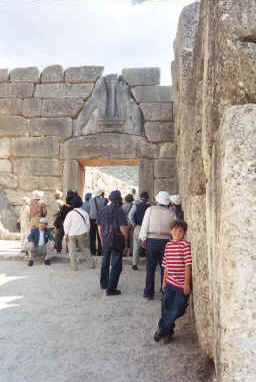 Julian stands below the Lion Gate
|
According to legend, Agamemnon, king of Mycenae, was the supreme leader of the Greek invasion of Troy. Menelaus, his brother, was Helen's cuckolded husband. On the way to Troy, the gods commanded that Agamemnon sacrifice his daughter, Iphigenia, at Aulis to allow the Greek fleet to sail to Troy. In retribution, his wife Clytemnestra (sister of Helen) with the help of her lover, Aegisthus, murdered Agamemnon in his bath after he returned to Mycenae. In turn, Orestes--son of Agamemnon and Clytemnestra--killed Aegisthus and his mother, partly due to prompting by his sister, Elektra, who so adored her father that she wasFreud's namesake for the "Electra Complex" (the female counterpart to the Oedipus Complex). Whether any of these people ever lived or any of this is remotely true is uncertain, but it sure makes a great story!
The ruins are famous primarily for the Lion Gate, erected around 1250 BC, and the tholos (an underground beehive-like structure) tombs found there. The Lion Gate is particularly impressive, not merely because of the sculptures but because of the truly monumental size of the blocks used to construct it. You can get a sense of this in the photo on the left: notice, in particular, the size of lintel block that supports the lion sculptures. The style of construction seen at Mycenae and other contemporary ruins is called Cyclopean. The ancients said these structures were built by the Cyclopes, probably because they thought mere humans would not have been large enough or strong enough to move the blocks. |